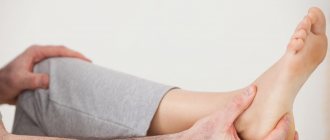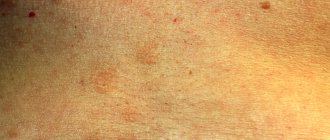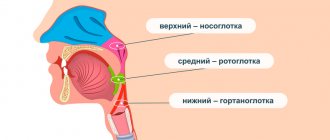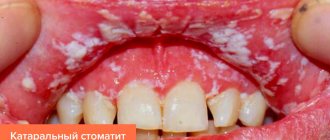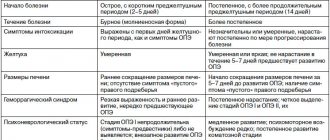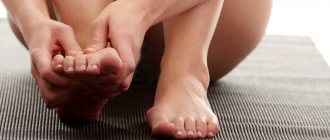Published: 11/03/2021 10:00:00 Updated: 11/03/2021
Urticaria is an allergic disease, the causes of which in children and adults can be very different. The main symptom of the disease is the appearance of blistering rashes on the skin, which are very itchy and resemble a nettle burn.
According to statistics, 25% of the entire population of the planet has encountered this pathology at least once in their lives, mainly children and women under the age of 40. With constant contact with the allergen, the disease becomes chronic, and in half of all cases it is accompanied by Quincke's edema.
Reasons for the development of urticaria
Hives never develop on their own; there is always a reason for this.
In some cases, identifying it is not difficult, but sometimes it is difficult to do. Most often, urticaria in children appears after using certain medications or eating certain foods. The most allergenic foods for babies are honey, nuts, fish, food additives, spices, sausages, and processed foods. Therefore, they are not recommended for children under 3 years of age.
Also, provoking factors include:
- insect bites;
- the presence of parasites in the body;
- plant pollen;
- mold;
- chemicals, including household chemicals;
- latex;
- ultraviolet radiation;
- vibration.
However, it is not always possible to find out what exactly the patient developed allergic urticaria to. In about a third of all patients with this diagnosis, the causes of the disease, even after numerous tests and analyses, remain unknown.
Treatment of the disease
If the allergen is known, then the main recommendation is to avoid, if possible, contact with the substance that provokes hives. That is why accurate diagnosis is important - it is necessary to understand which group of chemical compounds can lead to the development of urticaria. It often happens that the same substance is found in different foods or in different pharmaceuticals. And an allergy to pets can affect only one breed or spread to almost all pets, from cats to hamsters.
Therapy is needed if the disease has become a recurrent form - this happens if it is impossible to stop contact with the provocateur. In a situation where test results show the presence of an infectious focus, it is necessary to determine the infectious disease. It is likely that the urticaria will go away after healing.
If a patient is diagnosed with an allergy to dust, food or plants, then lifestyle changes are required: frequent wet cleaning, following a proper diet and avoiding walking during the flowering period of plants. Concomitant treatment is designed to alleviate symptoms when they reappear.
Symptoms of urticaria
The main manifestation is the appearance on the skin of red or pink spots of various shapes, and blisters, the size of which can reach several centimeters.
A slight swelling may appear, which gradually disappears over the course of a day, rarely two. If the swelling affects the deeper layers of the skin or mucous membranes, angioedema may result - a life-threatening condition that requires immediate medical intervention.
The rash of allergic urticaria is always accompanied by unbearable itching, and some patients describe it as an unbearable burning sensation. Violent scratching of such areas can lead to infection of the epidermis with further complications in the form of pustules and wounds.
Minor manifestations of urticaria include:
- headache;
- elevated temperature;
- sleep disorder;
- anxiety;
- loss of appetite.
According to the nature of the course, allergic diseases are divided into two types.
Acute urticaria is diagnosed most often. Blisters and swelling of the skin in this form appear completely suddenly, sometimes against the background of a person’s excellent health. Most often caused by some external reasons, food. It also happens after using medications, especially when self-medicating. Symptoms go away on their own within a few days to several weeks.
Chronic urticaria is a condition in which symptoms continue to persist for more than 6 weeks after the first rash on the skin. This variant is characterized by a wave-like course, when periods of complete absence of symptoms (recovery) are abruptly replaced by exacerbations with the appearance of a new portion of spots and blisters. This is accompanied by unbearable itching and rapid development of Quincke's edema. The emerging elements of the rash can merge with each other, covering more and more new areas of the skin.
Sometimes periods of complete well-being without symptoms can last for a long time - up to 10 years.
Children's urticaria is an allergic skin disease, which most often develops against the background of an existing exudative diathesis and appears due to food products introduced as complementary foods.
It has been noticed that this type of allergy mainly develops in babies who are bottle-fed or eat foods that are not appropriate for their age.
Chronic urticaria: drug of choice
XP
onic idiopathic urticaria (IU) is a skin disorder that affects 0.1–3% of the population. CHI usually affects people of working age, since the onset of the disease often occurs in the second and fourth decades of life, with at least one episode of urticaria occurring throughout life in 15–20% of both children and adults. Chronic urticaria is diagnosed twice as often in middle-aged women, which is due to the presence of dishormonal and neuroendocrine disorders [1, 2]. In approximately 50% of patients, chronic urticaria is combined with Quincke's edema [3]. In patients with CIC, the quality of life is significantly impaired, which is expressed in sleep disturbances, changes in the emotional background, and the occurrence of certain problems in everyday life [4, 5]. Urticaria can be either an independent disease or a symptom of a number of diseases. Clinical manifestations of urticaria are the result of the release and synthesis of mediators, mainly by mast cells located in the skin, which is caused by immune, non-immune, and idiopathic factors. The primary element in urticaria is a blister - urtica. When pressed, the urticarial element turns pale, which indicates the presence of dilated blood vessels and edema in the skin lesions. Urticarial rash is accompanied by itching, which intensifies at night and lasts from a few minutes to 48 hours [6]. After a specified period, the elements of the rash disappear without a trace, however, new rashes may appear at different times in other parts of the body (Fig. 1) [7]. At the histological level, it is swelling and perivascular infiltration of lymphocytes, mast cells, eosinophils and neutrophils of the epidermis and upper layer of the dermis with compression of veins and lymphatic vessels. Urticaria and Quincke's edema can develop together or separately. If the swelling involves the skin and subcutaneous tissue, the condition is called angioedema, or angioedema. With urticaria, only the superficial layers of the skin are involved in the process. With Quincke's edema, the itching is less pronounced, but the pain and burning sensation are similar. Urticaria can occur on any part of the body, while angioedema occurs most often in areas rich in connective tissue, such as the face, limbs and genitals. Unlike other forms of edema, there is no symmetry in its location (Fig. 2) [8].
There are acute (up to 6 weeks) and chronic (more than 6 weeks) urticaria. When rashes appear repeatedly, recurrent urticaria is diagnosed. Urticaria is most often associated with food and drug allergies, and can also be mediated by helminthic infestation or viral infection. Moreover, in half of the patients the cause of the urticarial rash cannot be identified - such urticaria is designated as idiopathic. It was previously believed that urticaria was mostly idiopathic, accounting for 80–95% of all urticaria cases. In the literature of recent years, the name “idiopathic urticaria” has become less and less common; the term “chronic urticaria” has become more common, since during many years of observation of patients with a previously established diagnosis of “idiopathic urticaria”, many researchers identified an autoimmune genesis in 35-55% of cases [7, 8]. Chronic urticaria can also be mediated by parasites, which is explained by their stimulating role in the development of the IgE immune response, however, clinical resolution of urticaria by eliminating parasites is achieved only in 8–16% of cases [9]. One of the reasons for increased activation of mast cells in patients with chronic urticaria is often identified infectious and inflammatory pathology of the digestive tract. Helicobacter pylori infection has also been implicated in chronic urticaria. It has been established that the frequency of its detection among patients with urticaria and in the population is the same. However, the immune response to H. pylori may differ in patients with urticaria. Moreover, an analysis of existing studies revealed that remission of urticaria is more likely in cases where antibacterial therapy leads to eradication of H. pylori [10]. In some patients, a combination of chronic urticaria with autoimmune pathology of the thyroid gland was found, accompanied by the detection of antithyroid antibodies in the serum, which may be a marker of an autoimmune nature, however, the mechanisms of the connection of antithyroid autoantibodies with mast cell activation remain unclear [11]. With CIC, urticarial elements persist longer than with various types of physical urticaria - usually up to 8-12 hours and are accompanied by more severe itching, especially in the evening and at night. With CIC, 25–45% of patients show signs of an autoimmune disease. In such patients, the level of serum immunoglobulin E (IgE) is significantly lower, and severe itching is added to the abundant and widespread urticarial rash [12]. When examining skin biopsies in patients with CIC and the presence of FcεRI/IgE antibodies, perivascular infiltrates are often detected, mainly consisting of neutrophils, eosinophils and mononuclear cells [13, 14]. Almost a third of patients with CIC have autoimmune reactions to thyroid tissue. However, most of them do not have any clinical symptoms of damage to the thyroid gland and changes in hormone levels; there is a decrease or disappearance of urticaria symptoms after the administration of L-thyroxine [11, 14–16]. In addition to assessing the history, clinical symptoms of the disease and its course, laboratory tests help in the differential diagnosis of chronic urticaria: • skin tests or determination of specific IgE antibodies in the blood can reveal the connection of the rash with food, medications, insect bites, plant pollen, animals; • sowing in the presence of a chronic focus of inflammation to isolate a culture of bacteria and determine their sensitivity; • study of thyroid function; • stool analysis for helminth eggs; • tests for the presence of autoantibodies; • complete blood count, ESR, determination of C-reactive protein; • detection of H. pylori [17] . The main drugs in the treatment of chronic urticaria are antihistamines. Despite the fact that first generation antihistamines (diphenhydramine, hydroxyzine, etc.) effectively eliminate the symptoms of urticaria, their use is associated with a large number of side effects. These include drowsiness, anticholinergic effect (dry mucous membranes, dizziness, constipation, urinary retention, etc.), impaired memory and attention, which can persist for 24 hours after taking the drug. According to the International Guideline for the Treatment of Urticaria (EAACI/GA2LEN/EDF/WAO management guideline), first generation antihistamines (sedatives) should not be used as first-line treatment for patients with urticaria. The only exceptions can be those situations when it is impossible to use second generation antihistamines. Currently, the priority is to prescribe non-sedating antihistamines of the second generation. These drugs, devoid of the side effects inherent in first-generation antihistamines, are no less effective at blocking H1 receptors for histamine and suppressing the symptoms of urticaria, significantly improving the quality of life of patients [18, 19]. Among the “non-sedating” antihistamines, desloratadine (Elysea), which is the primary pharmacologically active metabolite of the well-known loratadine, deserves special attention. Desloratadine is a drug that enters the body in the form of an active substance, which ensures its higher safety profile. It was synthesized in 1998 and registered in Russia in 2001. Desloratadine has the ability to suppress the acute phase of the allergic response by blocking H1 receptors. In experimental studies, it was shown that desloratadine has the greatest affinity for H1-histamine receptors and slow dissociation from connection with them. Desloratadine binds noncompetitively to H1 receptors and, according to clinical studies, has 52, 57, 194 and 153 times higher activity than cetirizine, ebastine, fexofenadine and loratadine, respectively. The drug is rapidly absorbed after oral administration and is characterized by a high rate of achievement of maximum plasma concentration and a rapid onset of action (after 1.25–3.00 hours). The pharmacokinetics of desloratadine are linear and dose proportional. The half-life of the drug is 21–24 hours, which allows it to be administered once a day. Eating does not affect the rate and degree of absorption of the drug. It was found that the pharmacokinetics and bioavailability of desloratadine are the same when taking the drug on an empty stomach and after a standardized meal in healthy people (the maximum concentration on an empty stomach and after a meal was 3.30 and 3.53 ng/ml, respectively, p = 0.17). Consequently, the drug can be taken regardless of meals, which indicates the convenience of its use. Metabolism and excretion of the drug do not depend on the age and gender of the patient [20–24]. Animal studies in vitro and in vivo have demonstrated that desloratadine, by inhibiting a number of inflammatory mediators, has additional antiallergic and anti-inflammatory effects not associated with blockade of H1-histamine receptors. At physiological concentrations, the drug effectively inhibits the production of histamine-dependent proinflammatory cytokines - IL-6 and IL-8, which are known to be released from endothelial cells, basophils and mast cells, and stimulate the secretion of proinflammatory mediators, such as tumor necrosis factor α. Desloratadine affects the activation and survival of eosinophils. Eosinophils, being the key effector cells in the allergic reaction, produce cytokines, chemokines, leukotrienes and neuromodulators. In addition, desloratadine, through inverse agonism, reduces the expression of nuclear factor κB (NF-κB), known as an inducer of RANTES, a major attractant for eosinophils, monocytes and T lymphocytes, promoting eosinophil activation and histamine release from basophils. Desloratadine is more potent than other antihistamines in inhibiting the activity of NF-κB, which stimulates the release of proinflammatory mediators from basophils and mast cells. In this effect, the drug is superior to cetirizine, loratadine and fexofenadine. Recent studies have shown that desloratadine may also inhibit mast cell degranulation and subsequent histamine release. In addition, desloratadine inhibits histamine-induced P-selectin expression [25–27]. Desloratadine is characterized by a high level of safety when used. It does not cause negative changes in the cardiovascular system and other organs, does not have a hypnotic effect and does not affect cognitive functions. The drug can be used by patients with pathologies of the hepatobiliary system and kidney diseases, and is approved for use in children from 1 year of age [23, 24]. Among the second generation antihistamines, desloratadine stands out for its more than 15 years of successful experience in widespread medical use and a large evidence base. The effectiveness and safety of desloratadine in the treatment of patients with CIC has been proven by numerous randomized, placebo-controlled clinical studies. J. Ring, R. Hein, A. Gauger conducted a multicenter, double-blind, placebo-controlled study that included 190 patients with moderate to severe CIC. During exacerbation of the disease, the 1st group of patients was prescribed desloratadine 5 mg/day, the 2nd group - placebo (control). The duration of treatment reached 6 weeks. The primary efficacy criterion was the average change in the itching index during the first 7 days of treatment compared to baseline. It was found that during the 1st week in patients receiving desloratadine, the itching index decreased by 56%, and in the control group - by 22%; a more rapid regression of skin rashes was also noted than in the control group. It was found that in patients from group 1 at the end of the 1st week of treatment, the degree of sleep disturbance when using the drug decreased by 53%, and in patients from group 2 - only by 18%. After 6 weeks During treatment with the drug, the itching index decreased by 74%, and during treatment with placebo – by 48.7%. By the end of the study, patients taking desloratadine experienced an almost 80% reduction in sleep disturbance. Both patients and doctors highly appreciated the overall positive dynamics of CIC symptoms and the response to treatment with desloratadine. The frequency of adverse events was comparable in the 2 groups; no serious adverse reactions were recorded [28]. In a more recent study, 137 patients with moderate to severe CIC were randomized into 2 groups. Patients from group 1 were prescribed desloratadine 5 mg/day, and patients from group 2 were prescribed placebo for 6 weeks. By the end of the study, the itching index in the desloratadine group decreased by 1.43, and in the placebo group by 0.86 (p = 0.004). After 6 weeks the number of patients with a complete, significant or moderate response to treatment was higher in the group of patients receiving desloratadine compared to patients receiving placebo (68.8 and 36.8%, respectively). No serious adverse events were reported, and the incidence of any adverse reactions was 11.1% in the placebo group and 6.2% in the desloratadine group [29]. Another study showed that desloratadine reduced the severity of the main clinical symptoms of CIC, primarily pruritus, by 50–70%. The effect of the drug lasted up to 24 hours. A decrease in symptoms of itching at the end of the desloratadine dosing interval was observed in 45% of patients (versus 4% of those taking placebo) and after 6 weeks. admission - 69%. There was also a significant decrease in the size and number of blisters during long-term use of desloratadine. Patients noted an 80% improvement in sleep. Assessment of the quality of life in patients with CIC while taking the drug for 7 days showed a decrease in scores on the Dermatology Life Quality Index (DLQI) questionnaire from 13.4 to 9.1. In 60% of patients during the specified period, the DLQI index decreased by an average of 2 points. By the end of the study, the proportion of such patients reached 77% (p<0.0001) [30]. In Germany in 2001–2002. 77,800 patients over 12 years of age were examined. Symptoms of allergic diseases were assessed before and after treatment. As a result of treatment with desloratadine, the vast majority of patients experienced relief of symptoms, which indicated a pronounced clinical effect [31]. A clinical study involving 12,050 patients confirmed the high therapeutic efficacy of desloratadine in CIC. At the same time, the absence of sedative influence and preservation of psychomotor functions were noted [32]. A number of studies were also carried out in Russia under the leadership of Yu.V. Sergeeva, N.V. Kungurova, I.M. Korsunskaya et al., aimed at assessing the effectiveness of desloratadine in the treatment of various dermatoses accompanied by itching. Therapy with desloratadine gave a positive effect in the form of a reduction in itching or its complete regression in 90% of patients. No side effects were observed during treatment with desloratadine [33–35]. Desloratadine meets all ARIA/EAACI criteria and is recommended as the first line of treatment for allergic dermatoses [36, 37]. It has special pharmacokinetic properties: it is quickly absorbed, its bioavailability is not affected by food or juice intake. The half-life of desloratadine is 21–27 hours, which allows its therapeutic activity to remain unchanged when taken once a day (unlike other second-generation antihistamines). Moreover, a study of the compatibility of desloratadine with other drugs did not reveal any significant interactions. A distinctive feature of desloratadine from other second-generation antiallergic drugs is its triple mechanism of action: it not only blocks H1-histamine receptors, but also has pronounced antiallergic and anti-inflammatory activity by inhibiting the synthesis of many other mediators by mast cells, basophils and other cells involved in the development of inflammation [ 38]. Desloratadine inhibits the development of not only the early, but also the late phase of the allergic reaction, which is associated with the accumulation of “inflammatory cells” in the lesion. This unique pharmacological effect of desloratadine suppresses the formation of chronic inflammation, which, in the absence of adequate therapy, can lead to a protracted course of the disease. Additional confirmation of the anti-inflammatory activity of desloratadine, associated with the suppression of not only allergic inflammation, is its ability to inhibit the development of erythema when exposed to ultraviolet B-range radiation [39]. The clinical efficacy and safety of desloratadine for chronic urticaria has been proven in multicenter, randomized, placebo-controlled, double-blind studies. Efficacy in suppressing itching was observed from the first day of use of the drug and persisted over the next 6 weeks. In addition, treatment with desloratadine led to the elimination or significant reduction in the severity of symptoms of CIC such as sleep disturbances, decreased activity and performance of patients. There were no side effects [40]. One of the drugs widely used in clinical practice is Elisea (desloratadine 5 mg). Since chronic urticaria is a long-term and recurrent disease, the drug is beneficial from a pharmacoeconomic position. It has antiallergic, antipruritic and antiexudative effects. Effective relief of urticaria symptoms when prescribing Elisea at a dosage of 5 mg occurs already on the first day of treatment, continues throughout the entire period of use of the drug and consists of a rapid and persistent reduction of rash, itching, improved sleep and activity of patients during the daytime, i.e. the use of Elisea for chronic urticaria is accompanied by a significant improvement in the quality of life of patients. Elisea has virtually no sedative effect, the drug does not affect cognitive functions (reading, driving). Elisey is prescribed from the age of 12, at a dosage of 5 mg (1 tablet), once a day, regardless of meals. The duration of treatment depends on the severity and form of urticaria. The high degree of safety and good tolerability give reason to recommend Elisey for the treatment of patients suffering from chronic urticaria.
Complications of urticaria
It is important to know what hives look like and to be able to provide first aid correctly.
This will help prevent the development of severe complications that can lead to death. Often urticaria is accompanied by Quincke's edema, which is also called angioedema. Its development in the larynx area is especially dangerous, as it can compress the trachea and impair breathing.
Another serious complication is anaphylactic shock. This is a life-threatening immediate allergic reaction that occurs when the human body is hypersensitive to a particular allergen. Usually develops upon repeated contact with the allergen and requires immediate medical attention.
Treatment of allergic urticaria in adults
Allergic urticaria is a dermatological reaction to exposure to a factor with a protein structure.
The disease is characterized by increased immune reactivity and is accompanied by specific rashes similar to nettle marks. In 40% of adult patients, the condition is combined with symptoms of angioedema1. It is characterized by isolated swelling of a part of the body with the formation of dense edema affecting the subcutaneous fat and dermis of the skin. Urticaria affects approximately 15-25% of the population, and in 30% the disease is chronic4.
The disease requires complex treatment aimed at eliminating the allergen from everyday life and blocking the mechanisms that provoke the formation of the rash. Ignoring the problem is dangerous, as the condition progressively worsens, up to anaphylactic shock. In addition, this type of allergy significantly worsens the quality of life and can cause psychological problems and neuroses.
Diagnosis of urticaria
Before starting treatment, it is important to understand what exactly a person has such a strong allergic reaction to.
Only by removing this provoking factor from your usual life can you not be afraid that the symptoms of urticaria will appear again, and this is possible even after proper therapy. Most often, this type of allergy appears to food. It is possible to determine what exactly caused the rash by a blood test: the level of IgE antibodies to a mixture of food allergens is detected. First of all, you need to diagnose the presence of an allergic reaction to:
- nuts;
- vegetables and legumes;
- citrus fruits and fruits;
- seafood;
- cereal and sesame flour;
- fruits and melons;
- baby formula;
- fish;
- meat;
- mushrooms;
- loose leaf tea;
- goat milk.
In addition to food, allergic manifestations can also occur to other substances that surround us almost everywhere in life:
- mold fungi;
- pollen from early flowering trees;
- pollen of late-flowering trees;
- weed pollen;
- epithelium of domestic animals;
- house dust;
- house dust mite;
- poultry feather.
To identify the exact type of allergen, allergy tests are performed on certain foods.
It often happens that rashes appear due to seasonings and herbs used in cooking: paprika, cumin, cloves, basil, ginger, tarragon, thyme, marjoram, dill, bay leaf, black pepper, vanilla. Some types of fish may also be allergenic: cod, halibut, mackerel, and squid meat. But sometimes an allergic reaction in the form of urticaria develops to such familiar products as:
- cucumber;
- apricot;
- cherry;
- tomato;
- plum;
- grape;
- persimmon;
- carrot;
- beet;
- watermelon.
All tests are carried out only by a specialist laboratory technician. You cannot independently determine the presence of an allergy in the form of urticaria to a particular food product or substance. This can be life-threatening, since it is possible to develop not only Quincke's edema, but also anaphylactic shock.
Causes of urticaria in adults
Allergic rashes are caused by the following environmental factors:
- Food (seafood, nuts, chocolate and other products containing cocoa, honey, eggs, dairy products, citrus fruits, exotic fruits, strawberries and other berries, various herbs for herbal tea);
- Medicines (penicillin antibiotics, acetylsalicylic acid and other NSAIDs, B vitamins, vitamin C, non-narcotic painkillers and any other medications in the form of individual intolerance);
- Insect bites: bees and wasps;
- Animal fur, saliva (by inhalation, bites or scratches);
- Plant pollen (rarely manifests itself as urticaria);
- Mold.
Sometimes the factor that caused the allergy is obvious due to the direct connection between the appearance of the rash and its exposure. For example, after eating a certain product. In some cases, it is not possible to determine the allergen on your own, so you have to conduct specific studies.
First aid for hives
It is important that you always have allergy medications in your home medicine cabinet, since urticaria in adults, and in children too, can appear at any time.
Allergy medications can be in the form of drops or tablets. Modern remedies do not cause drowsiness and have virtually no side effects. Doctors recommend having in your home medicine cabinet to eliminate urticaria and itching, Fenistil drops, which can be used from childhood, Erius tablets, which have a long-lasting antihistamine effect after administration, Loratadine, which helps cope with Quincke's edema, which often accompanies urticaria.
It is important to take the medicine at the first symptoms, without waiting for the general condition to worsen. If after 20 minutes from the moment of administration there is no improvement, you should call an ambulance.
For what indications is specialist consultation necessary?
Consultation with an allergist is necessary in case of exacerbation of chronic recurrent urticaria, as well as in intermittent acute form of the disease. The causes of diseases associated with urticaria can be determined by an allergist. It is also necessary to consult a dermatologist, rheumatologist, parasitologist, endocrinologist and, possibly, an oncologist.
Brief description of some clinical forms of urticaria
Allergic urticaria
- Most often acute or episodic
- The most common allergens are food, medications, insect poison, latex
- Patients also have other manifestations of allergy pathology, allergic heredity
- Positive results of allergological examination
- Elimination measures are effective
Autoimmune urticaria
- Current type of chronic idiopathic urticaria
- Frequent presence of autoimmune thyroiditis and thyroid diseases in the family
- Severe general symptoms (weakness, malaise, gastrointestinal dysfunction)
- Presence of histamine-releasing anti-Fcε-RI antibodies and anti-IgE antibodies
- Positive test with autoserum
Cold urticaria
- It can be acquired (idiopathic and arising against the background of an underlying disease, for example, viral hepatitis, lymphoproliferative disease, etc.) and congenital.
- The appearance of itching, burning, hyperemia, urticarial rash, angioedema in areas of the skin exposed to low temperatures
- Symptoms persist for 20-30 minutes and disappear without a trace after the patient warms up
- exposed
Delayed pressure urticaria
- Characterized by the appearance of swelling and blisters in pressure areas 4-6 hours after exposure.
- Characterized by resistance to treatment
Heat urticaria
- Occurs from exposure to heat.
- Hereditary local thermal urticaria has been described, characterized by a delayed (4-6 hours) appearance of elements after local thermal exposure.
- May be accompanied by systemic circulatory disorders and convulsions
Solar urticaria
- Occurs under the influence of ultraviolet radiation
- Blisters appear on exposed areas of the body after exposure to the sun; there may be fixed light urticaria
- The disease can be primary (idiopathic photic urticaria) and
- Secondary light urticaria may be associated with the action of drugs (tetracyclines, sulfonamides, quinolones) or associated with an underlying disease (SLE, thyroiditis, gastrointestinal dysfunction).
Dermographic urticaria
- The appearance of blisters due to mechanical irritation of the skin
- Itching precedes the appearance of rashes
- The phenomenon of dermographism is reproduced by intense line irritation of the skin with a blunt object (spatula)
Vibration urticaria/angioedema
- There are hereditary (autosmal dominant type) and acquired forms
- Characterized by the appearance of a rash and swelling in areas exposed to vibration
- Rash and swelling appear 4-6 hours after exposure to vibration and persist for up to 24 hours.
- The disease is caused by nonspecific degranulation of mast cells
Aquagenic urticaria
- The rash occurs only after contact with water of any temperature
- A rash with severe itching occurs immediately after contact with water
- Characterized by the appearance of small blisters surrounded by erythematous spots
Cholinergic urticaria
- Occurs more often in young people
- Characterized by the appearance of pale pink blisters with a diameter of 1-5 mm, often surrounded by erythema, the rash is generalized
- Provocative factors include exercise, stress, sweating, and hot showers.
- May be accompanied by systemic manifestations (hot flashes, weakness, rapid heartbeat, headache, abdominal pain, shortness of breath
- Can be reproduced by subcutaneous administration of acetylcholine
Adrenergic urticaria
- Rarely seen
- Characterized by the appearance of small papules with a white halo
- Triggered by stress
- Can be reproduced by intradermal injection of epinephrine
Anaphylaxis/urticaria caused by physical exertion
- Characterized by the appearance of skin itching, rashes, angioedema during or immediately after physical activity
- May be accompanied by systemic manifestations, including bronchospasm, laryngeal edema, vascular collapse
- A provoking factor may be the consumption of certain foods (alcohol, apples, shrimp, tomatoes, nuts, celery) before physical activity.
Treatment of urticaria
The only way to get rid of the disease is to avoid contact with the allergen, which is previously detected by laboratory tests.
If testing does not reveal a provoking factor, and the urticaria is episodic, then taking antihistamines will quickly eliminate the symptoms. During treatment, it is recommended to follow a diet that, in case of urticaria, will help prevent the recurrence of the disease. The menu should include only hypoallergenic products: lean boiled meat, soups with recycled meat broth or vegetarian. It is better to choose rice, buckwheat, and oatmeal from cereals. Low-fat cottage cheese, natural yogurt, apples, dried fruit compote, excluding raisins, and whole grain bread are recommended.
Citrus fruits, nuts, fish and all seafood, chocolate products, smoked meats, coffee, eggs, honey, and store-bought baked goods should be excluded from the menu during treatment.
Treatment is carried out by a dermatologist and an allergist-immunologist. For topical application, ointments for urticaria are effective; they not only relieve itching, but also eliminate swelling, redness and a burning sensation on the skin. One of the most effective is Dimetinden gel, which must be applied in a thin layer to the affected area of the skin up to 4 times a day.
A course of antihistamines is prescribed in the form of tablets. Your doctor may also prescribe calcium gluconate or calcium chloride for urticaria. They help reduce the symptoms of allergies, but they should only be administered under the supervision of a doctor in the treatment room.
If antihistamines do not provide the desired effect quickly, or for severe forms of hives, corticosteroids are used, which can be applied to the skin or taken in the form of tablets or injections.
Symptoms of urticaria
- Blisters can appear as pinpoint or large-focal, sometimes they merge with each other.
- A blister, the primary element in the manifestation of a skin rash, is a local swelling of the papillary dermis, which occurs as a result of accelerated blood flow, vasodilation, and increased vascular permeability.
- Blisters may also appear as cavityless exudative ephemeral elements. Dense, swollen, bright pink in color, they can rise above the skin level and have different shapes (large scalloped, rounded, etc.), different sizes (diameter - from 0.5 to 10-15 cm) and often a pale area in the center. Blisters may disappear without a trace (even after a few minutes).
- Sometimes there may be a burning sensation or a blister may be accompanied by unpleasant itching of the skin.
- Inflammation can occur anywhere. But most of all skin rashes appear in places where skin and clothing come into close contact: under straps, belts, and suspenders.
- The duration of the visual presence of the rash can range from several minutes to a day.
- In half of the patients, urticaria is accompanied by angioedema (Quincke's edema).
If swelling and rash have spread to the surface of the mucous membranes of the gastrointestinal tract, nausea and vomiting have appeared, this indicates a possible threat to human life and requires immediate intervention by a specialist.
Very often, urticaria is not treated and the disease is not given due importance. However, it is important to know that hives can be a signal of the appearance of diseases of the internal organs or some other serious infection in the body.
Do not forget about the predisposition to urticaria. This will be indicated by increased sensitivity of the skin and white stripes that remain after light scratching (white dermographism). If hidden infections are detected in time, the immune system will be able to function normally. It is important to assess the condition of the internal organs, being aware that if their functioning is disrupted, skin diseases may occur.
How long does it take to cure hives?
Within 4-6 weeks, acute urticaria resolves in almost all patients with this diagnosis.
However, sometimes the acute form can become chronic, and then the disease becomes incurable, with periods of exacerbation and complete remission with the absence of symptoms, which alternate with each other. To deal with this allergic reaction as quickly as possible, it is recommended:
- Immediately consult a doctor at the clinic or call an ambulance.
- Follow a hypoallergenic diet for several months.
- Follow all doctor's orders and recommendations regarding treatment. Do not stop taking allergy medications at the first signs of improvement, but complete the full course.
- Be sure to have modern antihistamines recommended by an allergist in your home medicine cabinet.
Author:
Pugonina Tatyana Alekseevna, Therapist
When and which doctor to contact
Usually a doctor is consulted:
- if the rash spreads over a large area;
- when symptoms increase;
- when signs of general intoxication occur;
- if the urticaria does not go away on its own after eliminating the factor that caused it;
- if the disease becomes chronic or often recurs,
It is advisable not to delay your visit to the doctor and come when the first manifestations of the disease occur. Then it will be easier to establish the cause, and treatment will take less time. In addition, the doctor will recommend what to do to prevent hives.
A therapist or pediatrician, a dermatologist can provide assistance with urticaria, and an allergist is involved in targeted diagnosis and treatment.
Prevention of urticaria
There are no special measures to prevent hives from occurring. Help minimize the risk of developing the disease:
- Keeping a food diary (you need to write down everything that was eaten during the day and how you feel).
- Avoiding contact with potentially dangerous allergic compounds (foods, medications, low/high temperatures, etc.).
- Pre-purchase antihistamines for urticaria. Allergists recommend that all people who have at least once had an allergy keep tablets such as Suprastin, Zyrtek, Parlazin, etc. on hand. If you take them at the first symptoms of the pathology, you can avoid complications.
- Wearing loose-fitting clothing made from natural fabrics (provides high-quality air exchange and avoids additional irritation of the skin).
- Avoiding stressful situations.
- Elimination of allergenic foods from the diet.
- Competent and timely treatment of chronic diseases.
This article is posted for educational purposes only and does not constitute scientific material or professional medical advice.
Causes of urticaria
Acute, new-onset or chronic induced urticaria may be a reaction to a viral infection, medication, food, exercise, intense sunlight, contact with animals, cosmetics, chemicals (such as latex or nickel), or may be caused by other causes.
Acute urticaria may be one of the manifestations of a parasitic infection. But since, according to WHO, parasite infections are not widespread in our region, when deciding whether to schedule an examination, it is necessary to take into account risk factors and other manifestations of infection (visiting regions with a high risk of becoming infected, eating raw fish or meat, the presence of gastrointestinal complaints). -intestinal tract, blood eosinophilia and others).
Most cases of chronic urticaria have no external causes.
Under the influence of external factors or without external causes, histamine and other substances are released from mast cells, swelling and itching of the skin begins, and rashes appear. Isolation can be caused by different types of immunological reactions. These may be allergic reactions, reactions caused by the influence of complement or immune complexes. Chronic urticaria is usually associated with autoimmune reactions, but there is no reliable test to accurately determine this.

